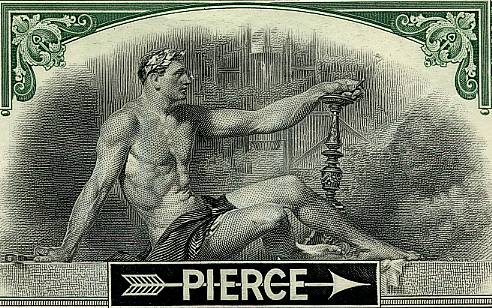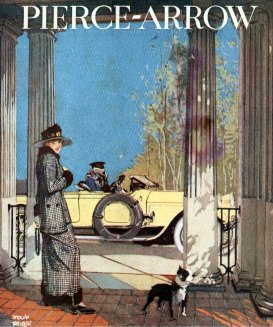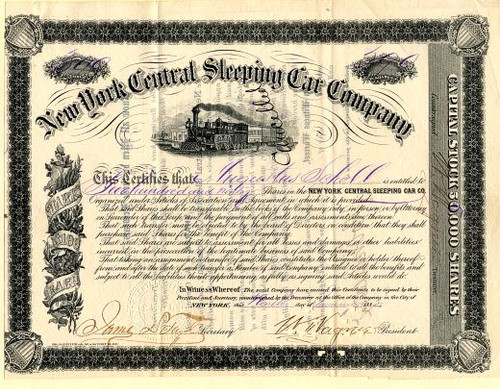Beautifully engraved uncancelled certificate from the Pierce - Arrow Motor Car Company issued in 1934. This historic document was printed by the American Banknote Company and has an ornate border around it with a vignette of an allegorical man sitting down looking off into the distance with the Pierce Arrow logo underneath him. This item has the printed signatures of the Company's President, and Secretary,. 
Certificate Vignette Pierce-Arrow was an American automobile manufacturer based in Buffalo, New York, which was active between 1901 and 1938. Best known for its expensive luxury cars, Pierce-Arrow also manufactured commercial trucks, fire trucks, camp trailers, motorcycles, and bicycles. 
Old Pierce - Arrow Motor Car Company Ad - shown for illustrative purposes 1919 Pierce-Arrow advertisement; ads for the cars in early years were understated and artistic, and did not discuss details about the cars. The forerunner of Pierce-Arrow was established in 1865 as Heinz, Pierce and Munschauer. The company was best known for its household items, and especially its delicate, gilded birdcages. In 1872, George N. Pierce bought out the other two, switching the name to George N. Pierce Company and, in 1896, bicycles were added to the product range. A failed attempt to build a steam-powered car was made in 1900 under license from Overman but, by 1901 Pierce built its first single-cylinder two-speed (no reverse) Motorette[1] with the engine licensed from de Dion. In 1904, a two-cylinder car, the Arrow was made. 19031927 1911 Pierce-Arrow Five-ton Truck 1915 Town Car, Salt Lake City, Utah Pierce-Arrow vehicles Model 48-B-5 7-Passenger Touring 1919 1922 Pierce-Arrow 1930 Pierce-Arrow Model B Dual-Cowl Phaeton 1934 Pierce-Arrow 840A Convertible 1934 Pierce-Arrow 840A Coupe In 1903 Pierce decided to concentrate on making a larger, more luxurious car for the upscale market, and the Pierce-Arrow car was born. This proved to be Pierce's most successful product, and the solidly-built cars with powerful engines gained positive publicity by winning various auto races. During this period, Pierce's high-end products were sometimes advertised as the Great-Arrow. George Norman Pierce sold all rights and the company in 1907 - He died in 1910. Future transactions and financial distresses are in no way his responsibility. In 1908 Pierce Motor Company was renamed The Pierce-Arrow Motor Car Company. The Pierce Arrow Factory Complex, designed by noted industrial architect Albert Kahn in about 1906, was constructed at Elmwood and Great Arrow Avenues. It was listed on the National Register of Historic Places in 1974. The Pierce-Arrow's engine capacity started as 11.7 liters and later was 13.5 liters. In 1909, U.S. President William Howard Taft ordered two Pierce-Arrows (along with a pair of White Model M Tourers) to be used for state occasions, the first official cars of the White House. An open-bodied Pierce-Arrow carried Woodrow Wilson and Warren G. Harding to Harding's 1921 inauguration. A restored 1919 Pierce-Arrow is on view at the Wilson Presidential Library. Herbert M. Dawley (later a Broadway actor-director) joined Pierce-Arrow in 1912, and designed almost every model until 1938.[4] In 1914, Pierce-Arrow adopted its most enduring styling hallmark when the headlights of the vehicle were moved from the traditional placement on either side of the radiator into flared housings molded into the front fenders of the car. This gave the car an immediate visual identification from the side; at night it gave the car the appearance of a wider stance. Pierce patented this placement and it remained in place until the final model in 1938, although Pierce always offered customers the option of conventional headlamps. A small minority of customers purchased these less distinctive models. Through 1914 Pierce-Arrow also produced a line of motorcycles. The Pierce-Arrow was a status symbol, owned by many Hollywood stars, corporate tycoons; royalty of many foreign nations had at least one Pierce-Arrow in their collections. In American luxury cars it was rivaled only by Peerless and Packard, which collectively received the accolade Three P's of Motordom. Industrial efficiency expert Frank Gilbreth[5] extolled the virtues of Pierce-Arrow, in both quality and in its ability to safely transport his large family. Its wheelbase was 12 feet 3 inches. Pierce-Arrow advertisements were artistic and understated. Unusual for automobile advertising, the image of the car was in the background rather than the foreground of the picture. Usually only a portion of the automobile was visible. The Pierce-Arrow was typically depicted in elegant and fashionable settings. Some advertisements featured the car in places an automobile would not normally go, such as the West and other rural settings, a testament to car's ruggedness and quality. Several second-hand Pierce-Arrow cars were bought by fire departments, stripped down to the chassis and engine, the wheelbase lengthened, and built back into fire engines. Some of these fire engines were in service for up to 20 years. 1928-1933 In 1928, the Studebaker Corporation of South Bend, Indiana, gained control of the Buffalo firm. The association was to last for five years, with moderate benefits to both companies' engineering departments, which continued to function as separate entities. 1933 Silver Arrow and the end of the line In 1933, Pierce-Arrow unveiled the radically streamlined Silver Arrow in a final attempt to appeal to the wealthy at the New York Auto Show. The car was well received by the public and the motoring press, being announced with the slogan "Suddenly it's 1940!" Pierce sold five examples but, since it was priced at $10,000 during the worst of the depression, the rich were hesitant to spend so much. The bodies were built at Studebaker, which subsequently assisted in rolling out a lower-priced production model. This, however, lacked many luxury features of the show car and still failed to generate enough sales. Starting in 1936 Pierce-Arrow produced a line of camper-trailers, the Pierce-Arrow Travelodge. They also produced a new V-12 sedan that was redesigned and considered the safest and most luxurious sedan back then. The Rio Grande Southern Railroad converted five Pierce-Arrow automobiles (and a couple of Buicks) into motorized railcars, effectively buses and trucks on rail wheels. The nickname Galloping Goose was soon applied to these vehicles, based on their waddling motion and honking horn. All still survive. Pierce was the only luxury brand that did not field a lower price car (e.g. as the Packard 120) to provide cash flow, and without sales or funds for development, the company declared insolvency in 1938 and closed its doors. The final Pierce-Arrow assembled was built by Karl Wise, the firm's chief engineer, from parts secured from the company's receivers. Pierce's holdings were sold at auction on Friday, May 13, 1938 which would probably include the 40 Arrows made in October 1938. The factory equipment used to make Pierce-Arrow V-12 engines was bought by Seagrave Fire Apparatus, who used it to make engines for fire engines. Revival of the name In 2006, a group of classic car enthusiasts from Switzerland bought the rights to the Pierce-Arrow brand which is being applied to a 10-litre, 24-cylinder car designed by Luigi Colani.[7] History from Wikipedia and OldCompany.com (old stock certificate research service).

Certificate Vignette

Old Pierce - Arrow Motor Car Company Ad - shown for illustrative purposes








